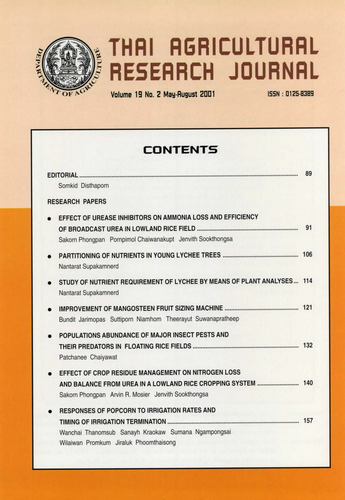Effect of Urease Inhibitors on Ammonia Loss and Effeciency of broadcast Urea in Lowland Rice Field
DOI:
https://doi.org/10.14456/thaidoa-agres.2001.8Keywords:
yclohexylhposphorictriamide, phenylacetylene, (N (n-butyl) phosphorictriamide, urea, NH3, Volatilization, flooded rice fieldAbstract
An experiment was conducted at the Suphanburi Rice Experiment Station on a Phimai soil (Vertic Tropaquepts) in the 1993 dry season to test the effects of two urease inhibitors, clohexylphosphorictriamide (CHPT) and N-(n-butyl) phosphorictriamide [(NBPT(0))] applied at the rate of 1% of the weight of urea either alone or imcombination with algicies (coper sulfate + terbutryn) and a nitrification inhibitor (phenylacetylene) on ammonia (NH3) loss and effciency of urea broadcast to lowland rice var. Suphanburi 90 at the rate of 9.6 kg N per rai.The results showed that the additionof aigicide reduced the growth of algae and maintained the pH of the floodwater below that of the control for 11 days following urea application. The two urease inhibitors markedly reduced urea hydrolysis and CHPT was more effective than NBPT (0). Addition of CHPT maintained the ammoniacal N concentration of the floodwater below 2 g m-3 for 11 days and resulted in reducing NH3 loss by ~ 90%. Application of NBPT (0)) and CHPT with urea did not result in a significant increase in grain yield of the urea applied alone (502.4 kg/rai). However, the addition of each urease inhibitor with algicide or algicide + nitrification inhibitor signficantly increased grain yield 9p < 0.05). The 15N balance measurement in the soil - plant system at crop harvest showed that NBPT (0) + algicide and NBPT (0) + algicide + nitrification inhibitor treatments doubled the recovery of applied N in the grain, while the corresponding CHPT treatments increased the recovery three fold. The recovery of applied N in the whole plant followed the similar trend of those found in the grain.
Downloads
Published
How to Cite
Issue
Section
License

This work is licensed under a Creative Commons Attribution-NonCommercial-NoDerivatives 4.0 International License.
Thai Agricultural Research Journal



